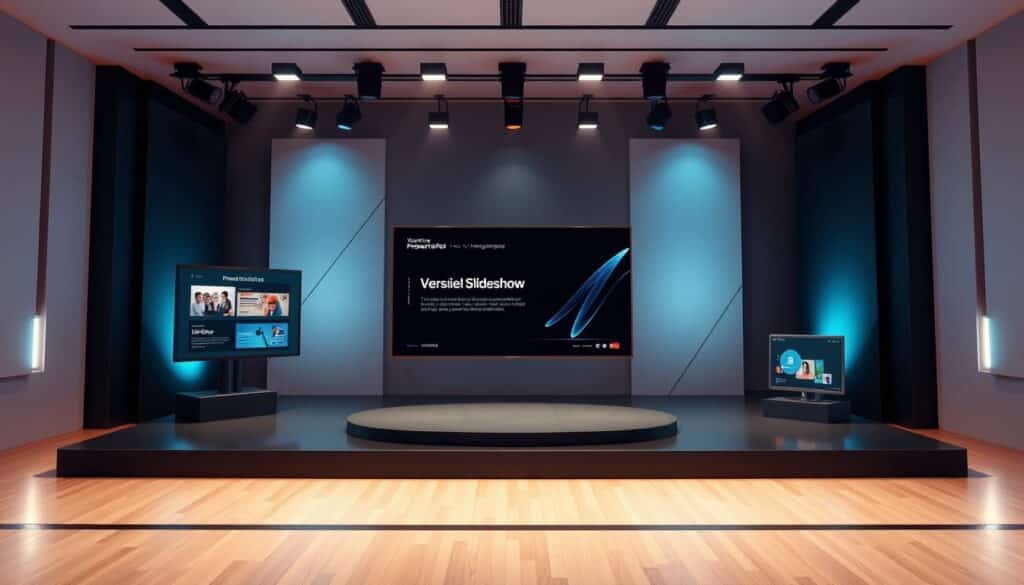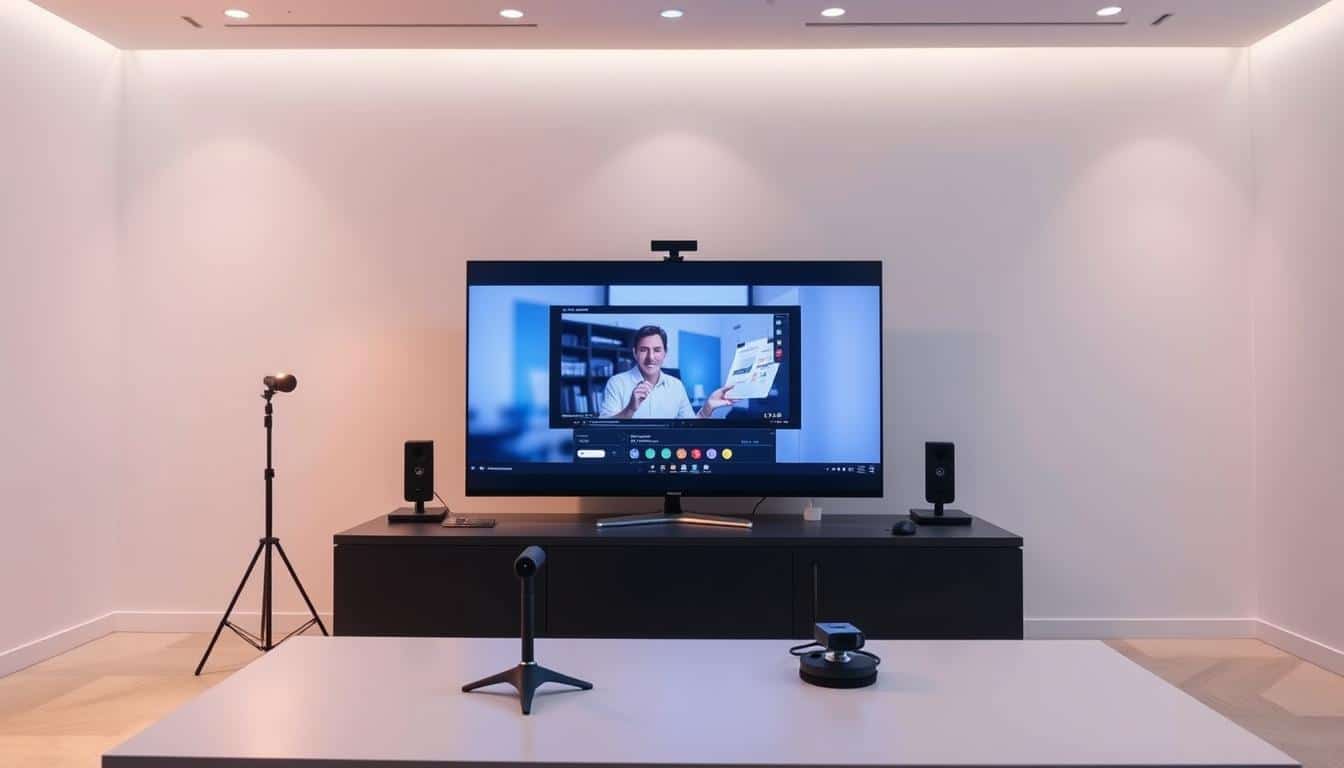In our world of remote work, knowing how to present well online is key. Because we now rely more on digital ways to communicate, keeping an online audience interested is tough. In virtual meetings, it’s easy for people to get sidetracked, unlike face-to-face meetings. So, it’s important for those running the meeting to use special tricks to keep everyone focused.
This piece shares important steps to make your online talks better and more lively. We’ll talk about setting up your tech right and making sure your audience can take part. These tips will help you make your virtual meetings more interactive and efficient.
Anúncios
Understanding the Importance of Virtual Meeting Presentations
Virtual meetings are key in the remote work world today. It’s crucial to know how important virtual presentations are. Platforms like Zoom, Microsoft Teams, and Google Meet need presenters to change their style to keep online meeting engagement high. Online audiences present new challenges, requiring fresh ways to share powerful messages.
The effects of virtual presentations matter a lot. Presenters need to grab their audience with engaging methods. Using multimedia keeps attention and makes the session lively. Tools like polls and interactive features boost participation. It lets people join in more by asking questions or commenting.
Keeping presentations short and to the point is a must. This helps the audience stay focused. Visuals are crucial. Use attractive images, graphics, and videos but don’t make slides too busy. Ending with a summary of key points helps remember the main messages. Sharing resources after helps further discussion and keeps interest alive.
Preparing Your Technology for a Seamless Experience
Getting ready is key to a great virtual presentation. Knowing your platform, like Zoom or Microsoft Teams, helps a lot. Learn about things like sharing your screen and interactive tools to make your meeting run smoothly. Make sure your tech is all set to avoid any surprises.
Know Your Presentation Platform
Each platform has its own cool features. Tools like the OnAIR platform boost engagement with live streaming, recordings, and polls. Knowing how to use these can make your presentation better. It’s smart to practice with these tools before you present.
Test Your Equipment Beforehand
Checking your gear is a must. Make sure your mic, camera, and internet connection work well. A good mic cuts down on background noise. Place the camera so it looks like you’re making eye contact. Practice with the setup you’ll use later. This helps you avoid tech problems and communicate better.
Getting the Right Environment Set Up
Creating a good presentation setting online can really affect how viewers take in what you say. A setting that looks good helps keep everyone focused on your main points. It’s important to think about the lighting and what’s behind you for online meetings.
Lighting: The Key to Visibility
Getting the lighting right is key for looking your best on video calls. Use light in front of you to avoid shadows on your face, which don’t look professional. Sunlight is great, but if there isn’t any, try using a desk lamp or a ring light. These help you look sharp and stay focused during your talk. Also, keep the camera at eye level to keep eye contact with your viewers.
Choosing an Appropriate Background
Your background in online meetings should show you’re serious but not distract from your talk. Pick a spot that’s tidy and fits your presentation’s vibe. If your real background isn’t great, use a virtual background or a blur option from your meeting app. This makes your setting look neat, so people pay more attention to what you’re saying. A good background makes your presentation better and keeps viewers interested.
Essential Virtual Meeting Presentation Tips
Success in virtual meetings depends on your ability to connect with and engage your audience. Using strong engagement strategies can turn a regular presentation into an interactive one. Effective visuals keep interest high and underline your main points.
Engage Your Audience
Virtual settings make it easy for distractions to occur. To fight this, add interactive elements like polls, Q&A sessions, or feedback on a shared canvas. With tools like Vibe Board, you can make your presentations more dynamic. Engaging the audience in these ways makes them more attentive and involved.
Use Visuals Wisely
It’s vital to boil down your content to the most important points and use different types of visuals, such as images, videos, and GIFs. This strategy keeps your audience focused. Ensure visuals are big and clear for small screen visibility. Switch up your visuals often but make sure they complement your talk.
Mastering the Art of Eye Contact and Body Language
In virtual presentations, creating a connection is key. Using eye contact well can really draw in your audience. To make it seem like you’re looking right at them, stare into the camera. It feels like you’re talking to each person one-on-one. Turn off your self-view to avoid distractions. This helps make your talk seem more personal and keeps your audience engaged.
Body language is also super important when you’re presenting online. Stand or sit up straight but stay relaxed. This shows you’re confident and professional. Also, use your hands to help make your point. But keep your movements within the camera’s view. This makes your main points more interesting without overwhelming your watchers.
Don’t forget about your facial expressions, either. A smile or a look of excitement can make you seem friendly and open. Make sure your camera is right at eye level and the lighting is good. This makes sure everyone can see your face clearly. Bad lighting or a weird camera angle can mess with how you come across. So, paying attention to these small things is super important.
When you mix good eye contact with the right body language, you really grab your viewers’ attention. This makes your presentations more fun and interactive.
Creating a Dynamic Presentation Structure
Effective structuring of virtual presentations enhances clarity and captures the audience’s attention. A clear structure allows participants to follow along effortlessly and retain key points. Prioritize simplifying complex ideas through chunking information. This method involves breaking your content into digestible segments, which can lead to more productive sessions.
Chunking Your Information
Chunking information is crucial for maintaining engagement during virtual meetings. Divide your content into smaller sections, with each segment lasting around 10-15 minutes. This aligns with adult learning principles, ensuring that your audience remains focused and retains information. Consider incorporating interactive activities such as polls and icebreakers within these segments to foster collaboration and participation throughout your session.
Utilizing the 10/20/30 Rule
The 10/20/30 presentation rule serves as an effective guideline for structuring virtual presentations. This rule suggests using no more than ten slides, maintaining a duration of twenty minutes, and employing at least a thirty-point font size. This approach guarantees a concise and visually accessible presentation, enhancing audience retention.
Employ simple fonts like Arial or Calibri, ensuring high contrast between text and background for better readability. Regular audience interaction through quizzes and discussions further promotes engagement, aligning perfectly with the overall aim of creating a dynamic presentation that resonates with your audience.

Effective Communication Techniques for Virtual Engagement
Mastering effective communication is key to successful virtual meetings. It’s not just about sharing info, but also handling audience interaction well. Setting clear times for questions improves understanding and keeps things lively. By using tailored ways to engage, presenters can keep everyone interested and active.
Managing Audience Interaction
To create a fun atmosphere, you can use:
- Games and quizzes for better participation.
- Virtual icebreakers like “Guess Who?” for a more relaxed setting.
- Quick-fire question sessions to make discussions more lively.
- Breakout rooms for deeper conversations.
- Themed days to make meetings more interesting.
These methods make meetings fun and help everyone feel more connected. Using advanced tools like Kumospace can make your virtual spaces even more exciting.
Incorporating Stories and Real-life Examples
Using stories in your presentations is very powerful. It links facts with feelings. To make complex ideas easier to grasp, use real-life examples. When telling stories, remember to:
- Start with a personal introduction.
- Use video for better expression.
- Sum up key points to ensure clarity.
- Finish with a celebration of achievements.
- Have casual talks or virtual coffee breaks to build relationships.
Stories make your presentations more engaging and help your audience care more about the topic.
Enhancing Your Presentation with Energy and Animation
Adding energy to your online talks is key to keeping your listeners hooked. Show excitement with how you speak and how you move. Use animations to make your slides more interesting. This will grab your audience’s focus.
Animations highlight important ideas and keep viewers attentive. But, use them wisely to avoid distractions. They should make your point clearer, not confuse it. Good animations also help you control how fast you go through your presentation.
Begin with fun questions to capture interest from the start. Add high-quality pictures, videos, and sounds to make it more interactive. Using tools like Prezi lets you move around your topic in an engaging way, keeping everyone interested.
Interactive animations can make your presentation fun with quizzes and menus that people can click on. Tools like iSpring Suite let you add quizzes and simulations that draw people in. Share special hashtags on social platforms and show live discussions to spark conversations.
Add Q&A segments and surveys to get instant reactions, making your session more engaging. The use of collaborative boards helps with sharing ideas live. Make sure to check all interactive parts work well before starting.
It’s important to balance fun interactions with valuable content. Using stories, including personal ones, helps connect with your audience deeply. Find out how effective your animations were by getting feedback and watching how people participated.
Virtual Meeting Presentation Tips for Success
Achieving success in virtual meetings relies on rehearsing well and connecting with your audience genuinely. You should practice several times, paying attention to your timing, what you’re saying, and how you’re engaging with your audience. Being authentic in your presentation makes you more likable and relatable. When you’re truly enjoying giving online presentations, it shows, and your audience feels more connected to what you’re sharing.
Practice Beforehand
It’s crucial to practice your presentation. You should have at least two practice sessions. Focus on being ready technically, how smoothly your content flows, and how you’ll interact with your audience. Below are some tips to help you during rehearsal:
- Set up an RSVP to gather attendee expectations and concerns.
- Prepare a tailored agenda based on attendee feedback.
- Utilize interactive tools like Vibe Board to enhance engagement.
- Encourage participation through polls and questions during your presentation.
Be Yourself and Have Fun
Being genuine in your presentation leads to more authenticity. Sharing personal stories and making eye contact with the camera makes the experience feel more connected. Consider these tips for a more enjoyable presentation:
- Choose a simple background to keep the audience’s attention on you.
- Turn off notifications and tidy your workspace to minimize distractions.
- Check your audio and internet connection before starting to prevent technical issues.
- Use bullet points on slides for clarity; include visuals like charts and videos to help explain.
- Design slides that focus on one main idea, with big, easy-to-read fonts.
- Plan a Q&A time to engage with your audience.
Evaluating Your Presentation Skills
Assessing your presentation skills is key to becoming a great public speaker. There are many ways to improve and grow. It’s important to get feedback from your audience. This gives you insights into your content and how you deliver it. Knowing how your audience feels helps make your presentations better.
Seek Feedback and Continuous Improvement
To learn, you need to ask for feedback on your presentations. You can get feedback from friends, mentors, or those who listened to you talk. You might use surveys or just ask people to share their thoughts. Focus on how you keep the audience interested and if your message is clear. Knowing your goals, like whether you want to inform or inspire, helps measure success.
Watching videos of yourself presenting is a great way to see what you’re doing well and what you can do better. Pay attention to your body language, eye contact, and how you use visual aids. This helps see what needs work. Thinking about what you did right and wrong after your talk helps you get ready for the next one.
Joining speaking clubs or workshops is another good way to get better. They offer chances to practice and take on new challenges. This builds your confidence and skills. The more you practice, the better your presentations will become.
Conclusion
In summary of virtual presentation tips, mastering this art is crucial in our digital world today. Over 53% of workers prefer virtual meetings. This shows how important it is to give powerful online presentations. The strategies mentioned, like preparing your technology, engaging with your audience, and using the right body language, make your presentation unforgettable.
When thinking about online presentations, using the PACES framework—Plan, Audience, Content, Engagement, Socialization—helps a lot. You should mix up your media and keep distractions low. Always aim to highlight your main message. This makes your key points stick and helps you connect more with your audience.
Having fun and being real with your audience is key. Ending your presentation with a thought-provoking question or a meaningful quote can spark more conversation. Also, saying thanks to your contributors makes the atmosphere positive. By using these tips and improving your skills, your virtual presentations will not only be successful but also inspiring.
FAQ
What are the key strategies for engaging an online audience during virtual presentations?
How can I ensure my technology is ready for a seamless virtual presentation?
What factors should I consider for setting up my physical environment for a virtual presentation?
What techniques can I use to enhance my body language during virtual presentations?
How important is audience engagement and what are effective ways to facilitate it?
What is the “10/20/30 Rule,” and how can it help my presentation?
How can I ensure I have the right energy and enthusiasm during my presentation?
What steps can I take for evaluating my presentation skills after the session?
Conteúdo criado com auxílio de Inteligência Artificial



